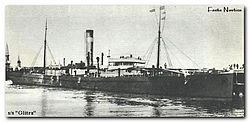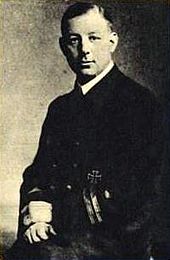Glitra
|
||||||||||||||||||||||
|
||||||||||||||||||||||
|
||||||||||||||||||||||
|
||||||||||||||||||||||
The Glitra was the first merchant ship sunk during the First World War . She was sunk on October 20, 1914 off the Norwegian coast by the German submarine U 17 .
history
The ship
The 866 GRT iron-built steamship was built at Swan Hunter in Wallsend and launched on March 3, 1881. It was christened Saxon Prince and commissioned as a cargo ship for the British Prince Steam Shipping Company ( Prince Line ) in 1884 . She was the first steamship of the Prince Line, which had been founded in 1884 by the ship magnate James Knott . Knott had been in the shipping industry since 1875, but until then his fleet had consisted only of sailing ships.
The 65.53 meter long and 9.14 meter wide Saxon Prince served the Prince Line for eleven years until it was sold to the shipping company Christian Salvesen & Co. from Leith near Edinburgh in 1895 . It was renamed Glitra and drove for Salvesen for 19 years.
Sinking
On October 18, 1914, the Glitra ran under Captain L. Johnston with a cargo of coal, iron and oil in the small town of Grangemouth near Falkirk with destination Stavanger . Two days later, at noon on October 20th, the ship was 14 nautical miles off the Norwegian coast and was about to take the pilot on board when the German submarine U 17 appeared on the starboard side under Lieutenant Johannes Feldkirchner, who stopped the steamer. An armed officer and two other submarine men then crossed over to the Glitra in a boat . The Germans ordered the British flag to be brought down and then searched the ship. Feldkirchner strictly adhered to the cruiser rules .
After the Glitra was searched, the 17-strong crew were given ten minutes to leave the ship. As soon as this had happened and everyone was safely disembarked, the Germans opened the sea valves in the engine room of the Glitra and put the ship under fire. The Norwegian torpedo boat Hai observed the stopping and sinking of the Glitra , but did not intervene because the incident occurred outside Norwegian territorial waters and Norway was a neutral state .
U 17 towed the two lifeboats for about a quarter of an hour towards the coast. After the submarine disappeared, the Hai approached , took the crew of the Glitra from the lifeboats on board and brought them to Skudeneshavn on the southwest coast of Norway. There were no fatalities. According to the New York Times , the ship was not insured.

